翻译理论概论(英文)
- 格式:ppt
- 大小:153.00 KB
- 文档页数:20
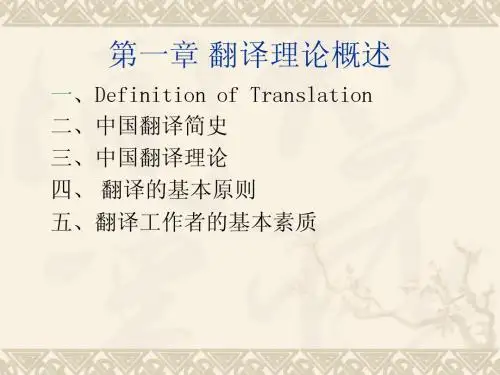
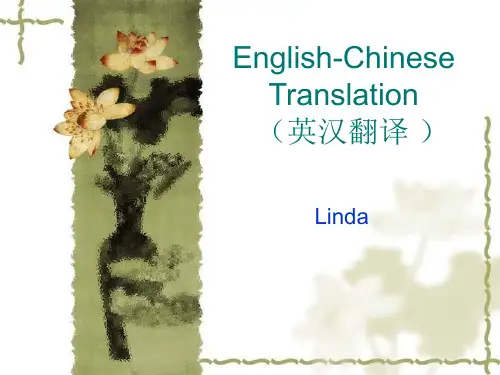
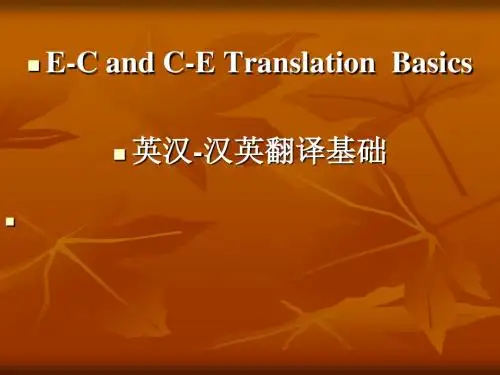
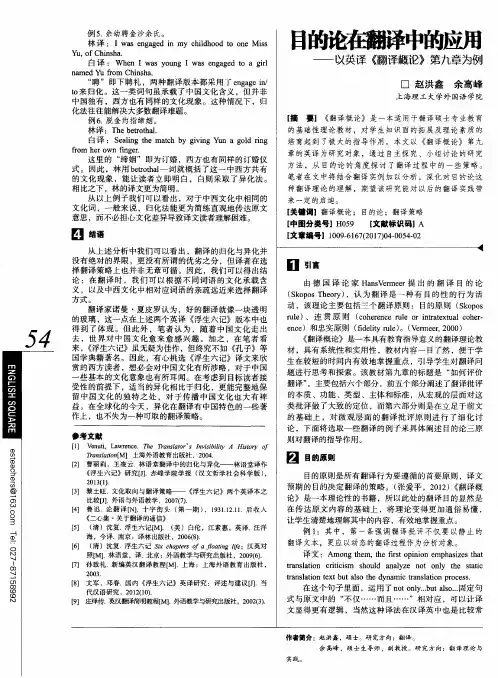
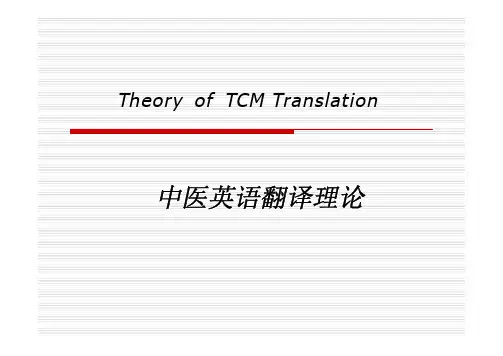
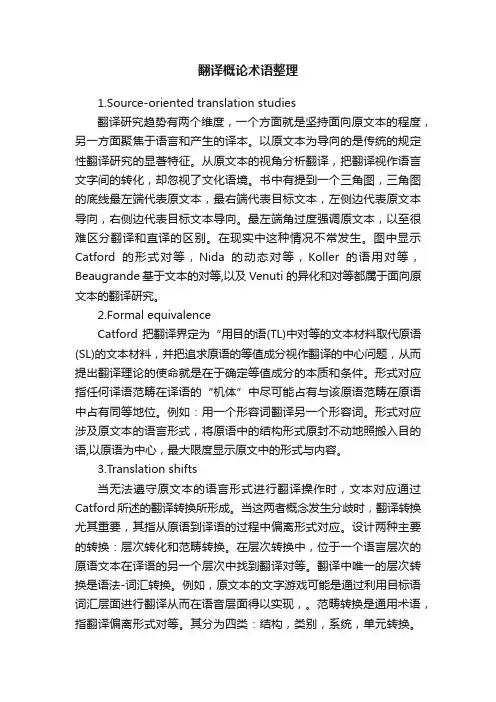
翻译概论术语整理1.Source-oriented translation studies翻译研究趋势有两个维度,一个方面就是坚持面向原文本的程度,另一方面聚焦于语言和产生的译本。
以原文本为导向的是传统的规定性翻译研究的显著特征。
从原文本的视角分析翻译,把翻译视作语言文字间的转化,却忽视了文化语境。
书中有提到一个三角图,三角图的底线最左端代表原文本,最右端代表目标文本,左侧边代表原文本导向,右侧边代表目标文本导向。
最左端角过度强调原文本,以至很难区分翻译和直译的区别。
在现实中这种情况不常发生。
图中显示Catford的形式对等,Nida的动态对等,Koller的语用对等,Beaugrande 基于文本的对等,以及Venuti的异化和对等都属于面向原文本的翻译研究。
2.Formal equivalenceCatford把翻译界定为“用目的语(TL)中对等的文本材料取代原语(SL)的文本材料,并把追求原语的等值成分视作翻译的中心问题,从而提出翻译理论的使命就是在于确定等值成分的本质和条件。
形式对应指任何译语范畴在译语的“机体”中尽可能占有与该原语范畴在原语中占有同等地位。
例如:用一个形容词翻译另一个形容词。
形式对应涉及原文本的语言形式,将原语中的结构形式原封不动地照搬入目的语,以原语为中心,最大限度显示原文中的形式与内容。
3.Translation shifts当无法遵守原文本的语言形式进行翻译操作时,文本对应通过Catford所述的翻译转换所形成。
当这两者概念发生分歧时,翻译转换尤其重要,其指从原语到译语的过程中偏离形式对应。
设计两种主要的转换:层次转化和范畴转换。
在层次转换中,位于一个语言层次的原语文本在译语的另一个层次中找到翻译对等。
翻译中唯一的层次转换是语法-词汇转换。
例如,原文本的文字游戏可能是通过利用目标语词汇层面进行翻译从而在语音层面得以实现,。
范畴转换是通用术语,指翻译偏离形式对等。
其分为四类:结构,类别,系统,单元转换。
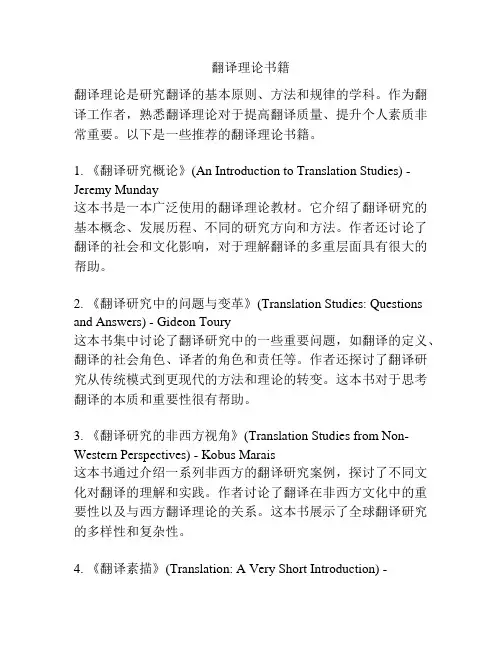
翻译理论书籍翻译理论是研究翻译的基本原则、方法和规律的学科。
作为翻译工作者,熟悉翻译理论对于提高翻译质量、提升个人素质非常重要。
以下是一些推荐的翻译理论书籍。
1. 《翻译研究概论》(An Introduction to Translation Studies) - Jeremy Munday这本书是一本广泛使用的翻译理论教材。
它介绍了翻译研究的基本概念、发展历程、不同的研究方向和方法。
作者还讨论了翻译的社会和文化影响,对于理解翻译的多重层面具有很大的帮助。
2. 《翻译研究中的问题与变革》(Translation Studies: Questions and Answers) - Gideon Toury这本书集中讨论了翻译研究中的一些重要问题,如翻译的定义、翻译的社会角色、译者的角色和责任等。
作者还探讨了翻译研究从传统模式到更现代的方法和理论的转变。
这本书对于思考翻译的本质和重要性很有帮助。
3. 《翻译研究的非西方视角》(Translation Studies from Non-Western Perspectives) - Kobus Marais这本书通过介绍一系列非西方的翻译研究案例,探讨了不同文化对翻译的理解和实践。
作者讨论了翻译在非西方文化中的重要性以及与西方翻译理论的关系。
这本书展示了全球翻译研究的多样性和复杂性。
4. 《翻译素描》(Translation: A Very Short Introduction) -Matthew Reynolds这本书是一本简明的介绍翻译的入门读物。
作者阐述了翻译的基本原则和技巧,并且用生动的例子解释了各种翻译问题和挑战。
这本适合没有太多翻译背景的读者,对于理解翻译的基本概念很有帮助。
5. 《翻译研究手册》(The Routledge Handbook of Translation Studies) - Carmen Millán and Francesca Bartrina这本手册提供了最新的翻译研究领域的综合性指导,包括各种不同的翻译理论和研究方法,以及研究中的关键主题。
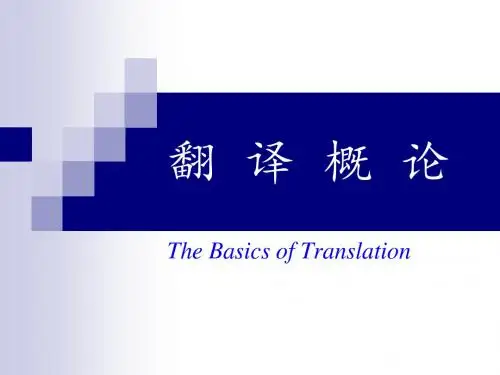
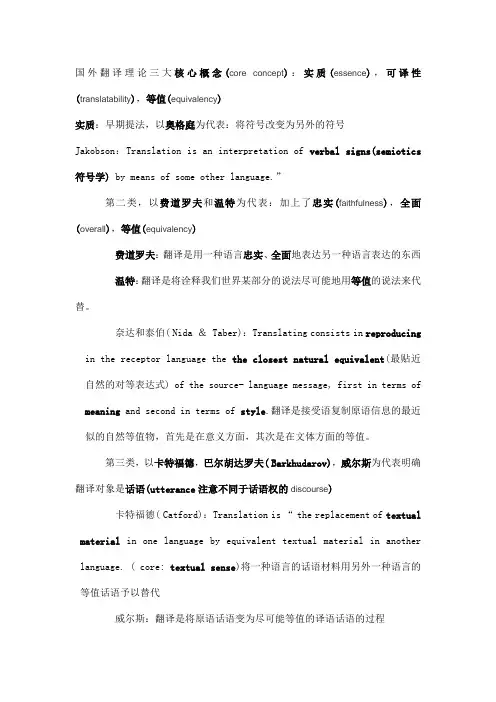
国外翻译理论三大核心概念(core concept):实质(essence),可译性(translatability),等值(equivalency)实质:早期提法,以奥格庭为代表:将符号改变为另外的符号Jakobson:Translation is an interpretation of verbal signs(semiotics 符号学) by means of some other language.”第二类,以费道罗夫和温特为代表:加上了忠实(faithfulness),全面(overall),等值(equivalency)费道罗夫:翻译是用一种语言忠实、全面地表达另一种语言表达的东西温特:翻译是将诠释我们世界某部分的说法尽可能地用等值的说法来代替。
奈达和泰伯( Nida & Taber):Translating consists in reproducing in the receptor language the the closest natural equivalent(最贴近自然的对等表达式) of the source- language message, first in terms of meaning and second in terms of style.翻译是接受语复制原语信息的最近似的自然等值物,首先是在意义方面,其次是在文体方面的等值。
第三类,以卡特福德,巴尔胡达罗夫( Barkhudarov),威尔斯为代表明确翻译对象是话语(utterance注意不同于话语权的discourse)卡特福德( Catford):Translation is “the replacement of textual material in one language by equivalent textual material in another language. ( core: textual sense)将一种语言的话语材料用另外一种语言的等值话语予以替代威尔斯:翻译是将原语话语变为尽可能等值的译语话语的过程巴尔胡达罗夫( Barkhudarov): A unit of translation is “ the smallest unit of SL which has an equivalent in TL.第四类,以什维采尔为代表,又增加了文化(culture)内容,王佐良先生(venerable Wang Zuoliang)认为:翻译工作者处理的是个别的词,面对的则是两大片文化。
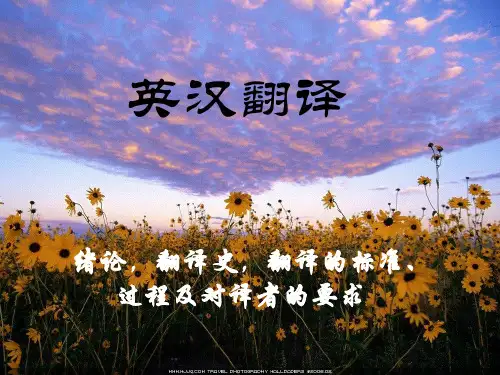
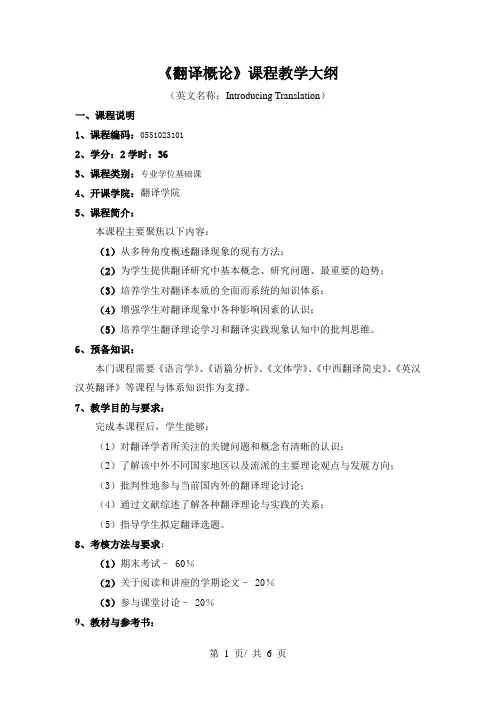
《翻译概论》课程教学大纲(英文名称:Introducing Translation)一、课程说明1、课程编码:05510231012、学分:2学时:363、课程类别:专业学位基础课4、开课学院:翻译学院5、课程简介:本课程主要聚焦以下内容:(1)从多种角度概述翻译现象的现有方法;(2)为学生提供翻译研究中基本概念、研究问题、最重要的趋势;(3)培养学生对翻译本质的全面而系统的知识体系;(4)增强学生对翻译现象中各种影响因素的认识;(5)培养学生翻译理论学习和翻译实践现象认知中的批判思维。
6、预备知识:本门课程需要《语言学》、《语篇分析》、《文体学》、《中西翻译简史》、《英汉汉英翻译》等课程与体系知识作为支撑。
7、教学目的与要求:完成本课程后,学生能够:(1)对翻译学者所关注的关键问题和概念有清晰的认识;(2)了解该中外不同国家地区以及流派的主要理论观点与发展方向;(3)批判性地参与当前国内外的翻译理论讨论;(4)通过文献综述了解各种翻译理论与实践的关系;(5)指导学生拟定翻译选题。
8、考核方法与要求:(1)期末考试– 60%(2)关于阅读和讲座的学期论文– 20%(3)参与课堂讨论– 20%9、教材与参考书:教材:Munday, J. 2008. Introducing Translation Studies: Theories and Applications (2nd Edition). London and New York: Routledge.参考书目:Baker, Mona. 1996. “Linguistics and Cultural Studies: Complementary or Competing Paradigms in Translation Studies?”. In Übersetzungswissenschaft im Umbruch: Festschrift für Wolfram Wilss, Angelika Lauer, Heidrun Gerzymisch-Arbogast, Johann Haller & Erich Steiner (eds.), 9-19. Tübingen: Gunter Narr Verlag. Benjamin, Walter. 1923/2000. “The Task of the Translator”. In The Translation Studies Reader, Lawrence Venuti (ed.), 2000, 15-25. London and New York: Routledge.Berman, Antoine. 1985/2000. “Translation and the Trials of the Foreign”. In The Translation Studies Reader, Lawrence Venuti (ed.). 284-97. London and New York: Routledge.Cheung, Martha. 2002. “Power and Ideology in Translation Research in Twentieth-Centur y China: An Analysis of Three Seminal Works”. In Crosscultural Transgressions, Theo Hermans (ed.), 144-164. Manchester, UK: St. Jerome Publishing.Even-Zohar, Itamar. 1990. "Polysystem Theory". Poetics Today 11(1): 9-26. Fawcett, Peter. 1995. “Translation and Power Play”. The Translator 1(2): 177-192. Gentzler, Edwin. 2001. Contemporary Translation Theories (2nd Rev. Edition).London/New York: Routledge. (chpt.5)Gutt, Ernst-August. 1991. Translation and Relevance: cognition and context. Oxford and Cambridge: Basil Blackwell. (pp.23-44; pp.170-195; pp.202-206)Gutt, Ernst-August. 1996. “Implicit Information in Literary Translation: A Relevance-Theoretic Perspective”. Target 8(2): 239-256.Holmes, James S. 1988. Translated!: Papers on Literary Translation and Translation Studies. Amsterdam: Rodopi. (chpt.6)Jääskeläinen, Riitta. 2000. “Focus on Methodology in Think-aloud Studies on Translating”. In Tapping and Mapping the Processes of Translation andInterpreting: Outlooks on Empirical Research, Sonja Tirkkonen-Condit and Riitta Jääskeläinen (eds.), 71-82. Amsterdam/Philadelphia: John Benjamins. Jakobson, Roman. 1959/2000. “On Linguistic Aspects of Translation”. In The Translation Studies Reader, Lawrence Venuti (ed.), 2000, 113-118. London and New York: Routledge.Neubert, Albrecht and Gregory M. Shreve. 1992. Translation as Text. Kent: The Kent State University Press. (pp.22-25; chpt.3)Nida, Eugene A. 1964. Toward a Science of Translating: with special reference to principles and procedures involved in Bible translating. Leiden: E. J. Brill.(pp.159-171)Nord, Christiane. 1997. Translating as a Purposeful Activity: F unctionalistA pproaches E xplained. Manchester, UK: St. Jerome Publishing. (chpt.7) Quine, Willard V. 1959. "Meaning and Translation". In On Translation, Reuben A.Brower (ed.), 1959, 148-172. Cambridge: Harvard University Press.Reiss, Katharina. 1977/1989. “Text Types, Translation Types and Translation Assessment”. In Readings in Transltion Theory, Andrew Chesterman (ed.), 105-115. Finland: Oy Finn Lectura Ab.Sperber, Dan & Deirdre Wilson. 1986. Relevance: Communication and Cognition.Oxford & Cambridge: Blackwell. (pp.46-53; pp.118-171)Steiner, George. 1998. After Babel: Aspects of Language and Translation (3rd Edition).Oxford/New York: Oxford University Press. (pp.312-319: “The Hermeneutic Motion”)Tirkkonen-Condit, Sonja. 2002. “Process Research: State of the Art and Where to Go Next?”Across Languages and Cultures 3(1): 5-19.Toury, Gideon. 1995. Descriptive Translation Studies and Beyond.Amsterdam/Philadelphia: John Benjamins. (Part One, chpt.2,Part Four) Venuti, Lawrence. 1995. The Translator’s Invisibility: A History of Translation.London and New York: Routledge. (chpt.1)Vermeer, Hans J. 1989/2000. “Skopos and Commission in Translational Action”. In The Translation Studies Reader, Lawrence Venuti (ed.), 2000, 221-232. Londonand New York: Routledge.Zhu, Chunshen. 2005. “Accountability in Translation Within and Beyond the Sentence as the Key Functional UT: Three Case Studies”. Meta 50(1): 312-335.二、教学内容纲要(共计36学时)Introduction (2学时)Chapter 1 Main issues of translation studies (4学时)1.1 The concept of translation1.2 What is translation studies?1.3 An early history of the discipline1.4 The Holmes/Toury “map”1.5 Developments since HolmesChapter 2 Translation theory before the twentieth century (2学时)2.0 Introduction2.1 “Word-for-word” or “sense-for-sense”2.2 Fidelity, spirit and truth2.3 Schleiermacher and the valorization of the foreignChapter 3 Equivalence and equivalent effect (4学时)3.0 Introduction3.1 Nida and “the science of translating”3.2 Newmark: semantic and communicative translation3.3 Later developments in equivalenceChapter 4 Studying translation product and process (4学时)4.0 Introduction4.1 Vinay and Darbelnet’s model4.2 Catford and translation “shifts”4.3 Option, markedness and stylistic shifts in translation4.4 The cognitive process of translation4.5 Ways of investigating cognitive processingChapter 5 Functional theories of translation (4学时)5.0 Introduction5.1 Text type5.2 Translatorial action5.3 Skopos theory5.4 Translation-oriented text analysisChapter 6 Discourse and Register analysis approaches (2学时)6.0 Introduction6.1 The Hallidayan model of language and discourse6.2 House’s model of translation quality assessment6.3 Baker’s text and pragmatic level analysis: a coursebook for translators Chapter 7 Systems theories (2学时)7.0 Introduction7.1 Polysystem theory7.2 Toury and descriptive translation studies7.3 Chesterman’s translation normsChapter 8 Cultural and ideological turns (2学时)8.0 Introduction8.1 Translation as rewriting8.2 Translation and gender8.3 Postcolonial translation theory8.4 The ideologies of the theorists8.5 Translation, ideology and power in other contextsChapter 9 The role of the translator: visibility, ethics and sociology (4学时) 9.0 Introduction9.1 The cultural and political agenda of translation9.2 The position and positionality of the translator9.3 The sociology and historiography of translation9.4 The power network of the translation industry9.5 The reception and reviewing of translationsChapter 10 Philosophical approaches to translation (2学时) 10.0 Introduction10.1 Steiner’s hermeneutic motion10.2 Ezra Pound and the energy of language10.3 The task of the translator: Walter Benjamin10.4 DeconstructionChapter 11 New directions from the new media (2学时) 11.0 Introduction11.1 Audiovisual translation11.2 Localization, globalization and collaborative translation 11.3 Corpus-based translation studiesChapter 12 Research projects (2学时)12.0 Introduction12.1 Research projects in translation studies。
Introduction概论English-Chinese,,,,,Translation,,,,,of,,,,,Practical,,,,,Stylistic,,,,,V arieties英汉应用文互译SYLLABUS⏹Introduction,,,,,⏹ 1.,,,,,English,,,,,brand,,,,,and,,,,,advertising,,,,,press⏹ 2.,,,,,English,,,,,for,,,,,contract,,,,,and,,,,,letter,,,,,⏹,,,,,3.English,,,,,for,,,,,sociability,,,,,writing⏹(sociable,,,,,letter/,,,,,testimonial/certification),,,,,⏹,,,,,4.English,,,,,for,,,,,daily,,,,,life⏹(instruction/names/introduction/poster/logo),,,,,Schools,,,,,of,,,,,translation⏹翻译的文艺学理论:艺术;译者的主动性和创造性⏹翻译的语言学理论:科学,SL和TL具有客观性,翻译过程种的语言现象的研究与分析⏹翻译的美学理论:审美过程;内容美,形式美,意境美⏹翻译的文体学理论:1960s,Halliday⏹“从文体学的观点来看,原文和译文在语言和题材的风格方面必须保持一致。
”,,,,,,,,,, ,,,,,,,,,,,,,,,,,,,,,,,,,,,,,,,,,,,,,,,,,,,,,,,,,,,,,,,,,,,,,,,,,,,,,,,,,,,,,,,,,,,,,,,,,,,,,,,,,,,,,,,,,,,,,,,,,,,,,,,,,,,,,,,,,,,,,,,,,, ,,,,,,,,,,,,,,,,,,,,,,,,,,,,,,,,,,,,,,,,,,,,,,,,,,,,,,,,,,,,,,,,,,,——布鲁姆菲尔德What,,,,,is,,,,,stylistic,,,,,varieties⏹Stylistics(文体学),,,,,,simply,,,,,defined,,,,,,is,,,,,a,,,,,discipline,,,,,that,,,,,studies,,,,,the,,,,,ways, ,,,,in,,,,,which,,,,,language,,,,,is,,,,,used;,,,,,it,,,,,is,,,,,a,,,,,discipline,,,,,that,,,,,studies,,,,,the,,,,,style,,,,,of,,,,,language,,,,,is,,,,,used.,,,,,⏹Language,,,,,,,,,,,,,,,The,,,,,way,,,,,,,,,,,,,,,The,,,,,style⏹Considering,,,,,different,,,,,communicative,,,,,environment,,,,,,methods,,,,,,objectives,,,,,and,,,,,purposes,,,,,,communicators,,,,,would,,,,,opt,,,,,different,,,,,lang uage,,,,,varieties,,,,,(语言变体),,,,,that,,,,,has,,,,,different,,,,,functions,,,,,so,,,,,as,,,,,to,,,,,perform,,,,,their,,,,, communication,,,,,effectively.,,,,,The,,,,,language,,,,,varieties,,,,,are,,,,,what,,,,,people,,,,,called,,,,,“style”,,,,,(文体或语体).Translation,,,,,techniques⏹直译与意译:,,,,,形式;意义⏹词类转换法:词性转化⏹增删法:词、词组、句子⏹句式转换法:句式特点;形合、意合⏹正反表达法:思维习惯⏹长句拆译法:语法结构和原文意义⏹变通手段:解释翻译、借译法、音译法、形译法应用文体的特点及其作用⏹ 1.应用文体的定义及其范畴⏹ 2.,,,,,应用文体的特点(文体)⏹ 3.,,,,,应用文体的功能与作用⏹ 4.,,,,,感受应用文体应用文体的定义⏹人们在日常工作和社会生活中为处理公私事务时所常用的具有直接使用价值和某种固定程式的各种文章的总称。